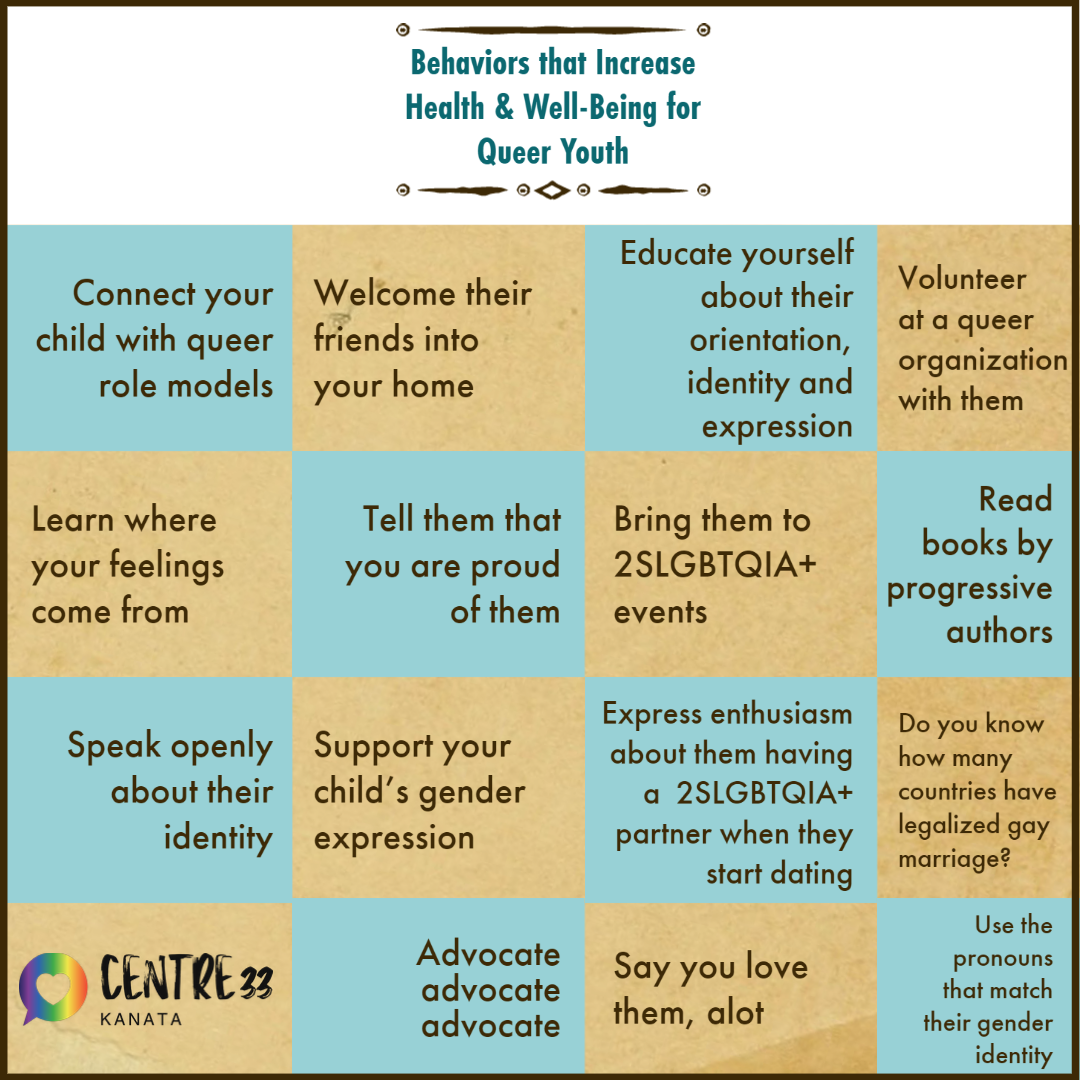At Centre33, we are pleased to provide youth-centered supports and referrals to carers, parents and family members.
You may find that the Pflag Canada network has resources to help. Check them out!
Gender

Should we talk to young children about gender diversity?
We communicate with children about gender from the moment they’re born. They are receiving messages and stereotypes about how "boys and girls" are supposed to look and behave, not only from adults, but also from peers, books, media, and through product marketing and advertising.
Research indicates that these messages place children in strict boxes which can prevent them from reaching their full potential.
Studies show how the messages kids receive about gender influence them at very early ages. For example, one study published in Science in 2017 showed that “At age 5, children seemed not to differentiate between boys and girls in expectations of 'really, really smart' — childhood’s version of adult brilliance. But by age 6, girls were prepared to lump more boys into the 'really, really smart'
category and to steer themselves away from games intended for the 'really, really smart.' ” If we don’t proactively teach different messages to children about gender, they will simply absorb the messages out there – and we all lose out.
What is gender congruence?
Gender congruence is the feeling of harmony in our gender:
- experiencing comfort in our body as it relates to our gender
- naming of our gender that adequately corresponds with our internal sense of who we are
- expressing ourselves through clothing, mannerisms, interests and activities
- being seen consistently by others as we see ourselves
Finding congruence is an ongoing process throughout each of our lives as we continue to grow and gain insight into ourselves. It is most often found through exploration. For some, finding congruence is fairly simple; for others, it is a much more complex process. But the fundamental need to find gender congruence is true for us all, and any degree to which we don’t experience it can be distressing.
How is gender different from sexual orientation?
Gender and sexual orientation are two distinct, but related, aspects of self. Gender is personal (how we see ourselves), while sexual orientation is interpersonal (who we are physically, emotionally and/or romantically attracted to).
When we confuse gender with sexual orientation, we are likely to make assumptions about a young person that have nothing to do with who they are. For example, when someone’s gender expression is inconsistent with others’ expectations, assumptions are frequently made about that person’s sexual orientation. The boy who loves to play princess is assumed to be gay, and the girl who buys clothes in the “boys’” section and favors a short haircut may be assumed to be a lesbian. These could be faulty conclusions. What someone wears and how they act is about gender expression. You cannot tell what a person’s sexual orientation is by what they wear (for that matter, you can’t know what their gender identity is either, unless they tell you).
Our society’s conflation of gender and sexual orientation can also interfere with a young person’s ability to understand and articulate aspects of their own gender. For example, it’s not uncommon for a transgender or non-binary youth to wonder if they are gay or lesbian (or any sexual orientation other than heterosexual) before coming to a fuller realization of their gender identity. How we come to understand our gender and our sexual orientation – and the choices we make to disclose and express these parts of ourselves – are distinct paths. Thinking of these two aspects of self as interchangeable may, instead of helping us know ourselves and one another better, actually get in the way of understanding and communication.
What is gender dysphoria exactly?
First, let’s look at the word “dysphoria.” According to Merriam-Webster, dysphoria is “a state of feeling very unhappy, uneasy, or dissatisfied.” So, in the broadest sense, gender dysphoria is when someone feels very unhappy, uneasy, or dissatisfied in relation to their gender. This is something many people experience, including feeling a tension between how someone feels about their body compared to how society genders their body, or a conflict between how someone sees themselves in contrast with expected gender roles or expectations.
Gender dysphoria is related to gender congruence, which is the degree of harmony we feel in each dimension of our gender. Gender dysphoria, which can occur in relation to any dimension of gender, can encompass a broad range of feelings, from mild discomfort to unbearable distress; the intensity, pervasiveness, frequency, and triggers of gender dysphoria vary widely from person to person. Feelings of gender dysphoria can, and often do, change over time. For example, an individual’s experience of gender dysphoria may lessen as greater congruence is achieved.
If a person’s discomfort or distress is negatively affecting their quality of life and relationships, they may want to get support from a trained, affirming gender professional. Keep in mind that “gender dysphoria” is also a clinical term and is found in the Diagnostic and Statistical Manual of Mental Disorders (commonly referred to as the DSM, or DSM–5). The labeling of gender dysphoria as a disorder or condition has been controversial, but it is helpful to understand the term’s clinical definition and use if you are considering support from a mental health professional.
Inspired to support our vision?
Donations can be made via the link/QR code below or by e-mail money transfer to centre33.books@gmail.com





